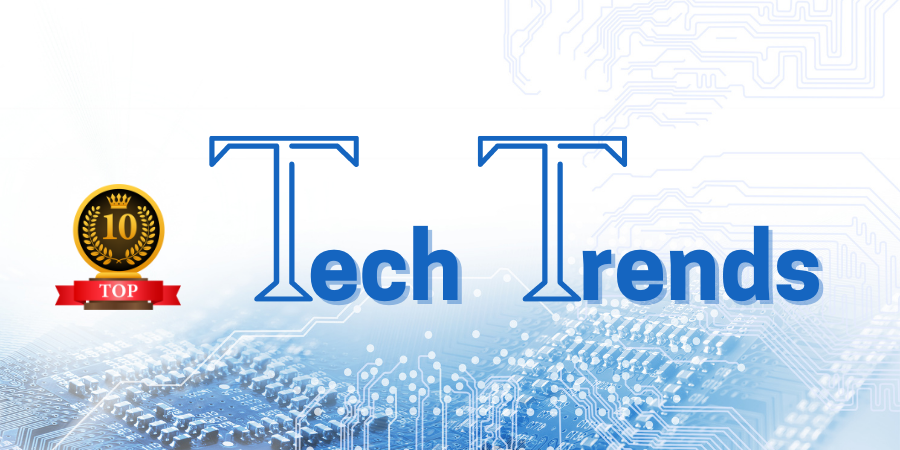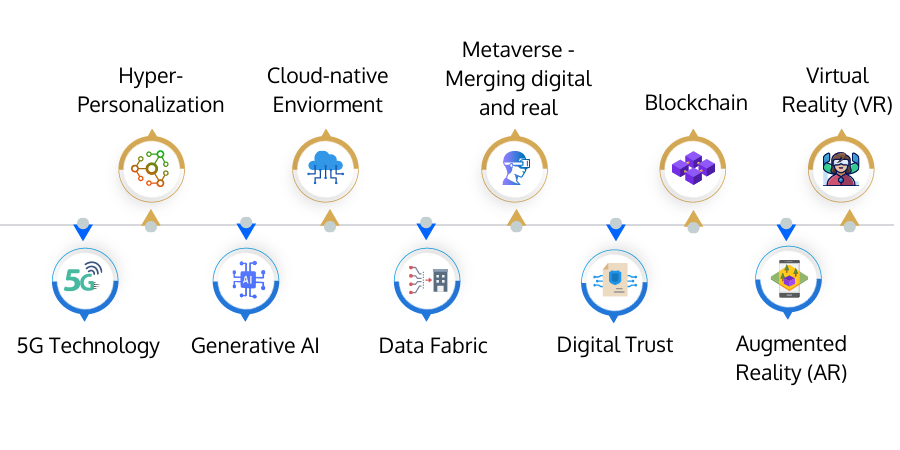
Technology continues to be a major driver of global change in this new normal. Technological advancements provide greater opportunities for corporations, governments, and social-sector institutions to increase productivity, develop and reinvent offerings, and contribute to humanity's well-being.
However, it is difficult to foresee how technology trends will unfold; leaders may plan ahead more effectively by following the development of new technologies, anticipating how organizations can use them, and understanding the variables that influence innovation and acceptance.
We are coming to the end of a year filled with technical breakthroughs that have shifted businesses toward a more automated and efficient model. The latest technological developments are paving the road for more connected businesses; this article will discuss the same.

Latest Future Technology Trends
The next wave of digital disruption is set to tap the market here, allowing forward-thinking businesses to be ready for the future.
Below is the list of 10 future technology trends gauging the momentum of the digital world:
1. Hyper-Personalization
Hyper-personalization- an AI-powered marketing strategiesHyper-personalization has continued to attract a larger segment of customers in 2023. Technology has enabled business leaders to bolster decision-making (data-driven choices) capabilities while improving employees and customer experience and leading businesses to advance marketing strategies.
As a result, employees benefit from increased flexibility, the ability to work efficiently, and an opportunity to adapt to work environments, thanks to hyper-personalization.
2. 5G Technology
5G technology allows smartphones to receive signals faster with lower latency. Spearheaded across nations, this technology enables mobile networks to be faster than 4G technology.
Incepted in 2020, the rollout of 5G aided in growth and development across industries by transforming how we access data and communicate. With its release, users can stream all their favorite shows, play high-quality games, and work at greater speed.
Furthermore, 5G impacts our daily lives by allowing streamlined live events, business conferences, and effective communication with low latency. This has improved the connectivity for IoT devices, network integration, and vertical market solutions.
3. Cloud-native Environment
With both public and private organizations having transmitted legacy IT infra (systems or networks) to the cloud via the 6R approach (rehost, re-platform, repurchase, rearchitecting, retire, and retain), developers are now adopting cloud platforms to design and develop new applications.
The approach to developing products or apps is driven by conventional cloud promises such as product development cycles, scalable managed services, innovative cloud capabilities, and hyper-automated technologies. However, cloud adoption also brings core challenges such as cost management, vendor lock-in, cultural changes, etc.
4. Generative AI
Generative AI implies the type of AI that uses unsupervised machine learning algorithms to build new digital objects, including images, video, audio, text, and code. This aims to generate synthetic data enabling the model to draw conclusions about the most important training data.
While generative AI is broadly employed in deep fakes and data journalism, the technology is becoming crucial in automating the repetitive processes used in digital image and audio correction. This is increasingly used in manufacturing as a rapid prototyping tool and in business to improve data augmentation for RPA.
5. Metaverse - Merging Digital and Real
Metaverse is a network of 3D virtual worlds facilitated by VR and AR devices that blurs the border between the physical and digital worlds or between actual and virtual realities. This real-time digital universe delivers individuals a sense of social presence, shared geographical awareness, and the potential to participate in a vast virtual economy with far-reaching societal impacts.
Metaverse aims to reduce carbon emissions - replacing tangible goods and meetings with digital ones, creating a physical presence with virtual interactions, or creating digital twins to help optimize the physical world.
6. Data Fabric
Data fabric is an environment utilizing intelligent and automated processes to enable constant capabilities across diverse endpoints. Its ultimate goal is to maximize the value of your data and accelerate digital transformation.
With the increasing volume of corporate data, data fabric stimulates cloud adoption globally with new growth opportunities. However, designing data fabric architecture employs a combination of built and bought solutions, and the technology demands huge investment.
7. Blockchain
Blockchain is a shared immutable ledger used to record transactions, track assets, and generate trust. A blockchain network can track and sell anything of value while lowering risks and costs.
In the digital-first era, businesses run on information. Users can track orders, payments, accounts, and production. The faster and more accurate it is received, the better. Blockchain provides immediate, shareable, and transparent data recorded on an immutable ledger.
8. Digital Trust
As long as people use smart devices and advanced technologies, confidence and trust in digital technologies have grown drastically. This incepted digital trust as a vital trend among leading innovations.
With digital belief, users started to think that technology can build a secure, safe, and reliable digital world (virtualized universe) while supporting businesses inventing and innovating products without worrying about losing customers’ trust. In this regard, cybersecurity and ethical hacking are two significant know-how businesses use to make the digital world safer.
9. Virtual Reality (VR)
VR transports users into an environment and helps them feel and experience the virtual environment firsthand by stimulating their hearing and vision. This is widely used in games; for example, Facebook's Oculus is leading the market with PlayStation VR.
VR is also employed in the entertainment industry; for example, some theme parks use VR to give their visitors a more immersive experience. AR can be used for education - entertainment, virtual museums, galleries, discovery centers, and theaters.
Another widespread application is training and simulation, such as surgery and flight simulation. Virtual reality systems, such as VirtualShip, are used to train the US Army, Coast Guard, and Navy.
While this technology has gained huge popularity, several limitations still hinder the immersion experience. Most high-quality hardware is expensive. For example, using a big clunky device is more expensive than using lite stand-alone headsets with lower graphical performance.
Shopify reports a 94% higher conversion rate for retail customers using AR/VR technology than those without.
10. Augmented Reality (AR)
AR is the real-time digital data integration with the user's environment. This blends digital and 3D components with a person's view of the real environment. AR is utilized for:
- Augmented navigation systems display routes over a real-time image of the road.
- To present a 3D image of the brain, helping neurosurgeons in surgery
- To view crucial elements such as speed and altitude via AR helmets, helping pilots in the military.
The technology poses some risks. People can get injured while playing games. Certain privacy risks exist. AR relies on data collection and redistribution, meaning there are possibilities for information leakage and legal issues.



























 Batoi Corporate Office
Batoi Corporate Office